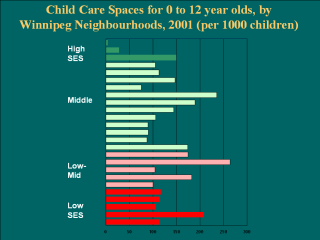 |
A somewhat similar problem of distribution and
access applies to child care spaces. We know high quality child care can
help prepare children for school, providing them with improved cognitive,
language and social skills (Peisner-Feinberg et al., 2001
(8) ). High quality
child care has been shown to be particularly effective at enhancing early
development for children from more disadvantaged backgrounds (Kohen,
Hertzman and Willms, 2002 (5)). For this reason, we would expect to find the
most generous supply of provincially licensed child care spaces in the Low
SES areas of the city. This graph shows the percent of licensed child care
spaces for children 0 to 12 years by Winnipeg neighbourhoods. It illustrates
that there is a wide range of supply across the city, from a low of less
than 5 spaces to a high of 263 spaces per 1000 children. The neighbourhoods
in this graph are ordered from highest SES at the top to lowest SES at the
bottom, and it is clear that the rate of providing child care spaces is not
reflecting the relative needs of residents across differing SES groups. |
